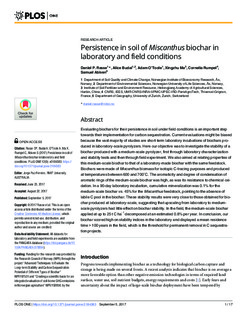| dc.contributor.author | Rasse, Daniel | |
| dc.contributor.author | Budai, Alice Erzsébet | |
| dc.contributor.author | O'toole, Adam Thomas | |
| dc.contributor.author | Ma, Xingzhu | |
| dc.contributor.author | Rumpel, Cornelia | |
| dc.contributor.author | Abiven, Samuel | |
| dc.date.accessioned | 2017-12-08T13:48:53Z | |
| dc.date.available | 2017-12-08T13:48:53Z | |
| dc.date.created | 2017-09-15T18:09:07Z | |
| dc.date.issued | 2017 | |
| dc.identifier.citation | PLoS ONE. 2017, 12 (9), . | nb_NO |
| dc.identifier.issn | 1932-6203 | |
| dc.identifier.uri | http://hdl.handle.net/11250/2469820 | |
| dc.description.abstract | Evaluating biochars for their persistence in soil under field conditions is an important step towards their implementation for carbon sequestration. Current evaluations might be biased because the vast majority of studies are short-term laboratory incubations of biochars produced in laboratory-scale pyrolyzers. Here our objective was to investigate the stability of a biochar produced with a medium-scale pyrolyzer, first through laboratory characterization and stability tests and then through field experiment. We also aimed at relating properties of this medium-scale biochar to that of a laboratory-made biochar with the same feedstock. Biochars were made of Miscanthus biomass for isotopic C-tracing purposes and produced at temperatures between 600 and 700°C. The aromaticity and degree of condensation of aromatic rings of the medium-scale biochar was high, as was its resistance to chemical oxidation. In a 90-day laboratory incubation, cumulative mineralization was 0.1% for the medium-scale biochar vs. 45% for the Miscanthus feedstock, pointing to the absence of labile C pool in the biochar. These stability results were very close to those obtained for biochar produced at laboratory-scale, suggesting that upscaling from laboratory to medium-scale pyrolyzers had little effect on biochar stability. In the field, the medium-scale biochar applied at up to 25 t C ha-1 decomposed at an estimated 0.8% per year. In conclusion, our biochar scored high on stability indices in the laboratory and displayed a mean residence time > 100 years in the field, which is the threshold for permanent removal in C sequestration projects. | nb_NO |
| dc.language.iso | eng | nb_NO |
| dc.rights | Attribution-NonCommercial-NoDerivatives 4.0 Internasjonal | * |
| dc.rights.uri | http://creativecommons.org/licenses/by-nc-nd/4.0/deed.no | * |
| dc.title | Persistence in soil of Miscanthus biochar in laboratory and field conditions | nb_NO |
| dc.type | Journal article | nb_NO |
| dc.type | Peer reviewed | nb_NO |
| dc.description.version | publishedVersion | nb_NO |
| dc.source.pagenumber | 17 | nb_NO |
| dc.source.volume | 12 | nb_NO |
| dc.source.journal | PLoS ONE | nb_NO |
| dc.source.issue | 9 | nb_NO |
| dc.identifier.doi | 10.1371/journal.pone.0184383 | |
| dc.identifier.cristin | 1494231 | |
| dc.relation.project | Norges forskningsråd: 192856 | nb_NO |
| dc.relation.project | Norges forskningsråd: 270624 | nb_NO |
| dc.relation.project | Norges forskningsråd: 197531 | nb_NO |
| cristin.unitcode | 192,14,0,0 | |
| cristin.unitname | Miljøvitenskap og naturforvaltning | |
| cristin.ispublished | true | |
| cristin.fulltext | original | |
| cristin.qualitycode | 1 | |

